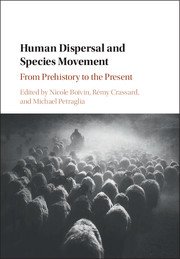Book contents
- Frontmatter
- Contents
- List of text boxes
- List of figures
- List of tables
- List of contributors
- Preface
- I Introduction
- II Origins: Species Movements in the Pleistocene
- III Across the water: Species movements by Coast and Sea
- IV Complexity: Species Movements in the Holocene
- V Invasion: The Movement of Invasive and Disease Species
- 15 Invasive eusocieties: Commonalities between ants and humans
- 16 Invasives, aliens, and labels long forgotten: Toward a semiotics of human-mediated species movement
- 17 Multiple time scales for dispersals of bacterial disease over human history
- 18 Early malarial infections and the first epidemiological transition
- 19 The globalisations of disease
- 20 Modern day population, pathogen and pest dispersals
- Index
- Plate section
- References
18 - Early malarial infections and the first epidemiological transition
from V - Invasion: The Movement of Invasive and Disease Species
Published online by Cambridge University Press: 04 May 2017
- Frontmatter
- Contents
- List of text boxes
- List of figures
- List of tables
- List of contributors
- Preface
- I Introduction
- II Origins: Species Movements in the Pleistocene
- III Across the water: Species movements by Coast and Sea
- IV Complexity: Species Movements in the Holocene
- V Invasion: The Movement of Invasive and Disease Species
- 15 Invasive eusocieties: Commonalities between ants and humans
- 16 Invasives, aliens, and labels long forgotten: Toward a semiotics of human-mediated species movement
- 17 Multiple time scales for dispersals of bacterial disease over human history
- 18 Early malarial infections and the first epidemiological transition
- 19 The globalisations of disease
- 20 Modern day population, pathogen and pest dispersals
- Index
- Plate section
- References
Summary
Abstract
Recent genetic and biomedical research has opened up new perspectives on the origins of human malarial infections in an era before the Neolithic agricultural revolution circa 12–10 ka. This chapter summarizes recent findings on the origins of the two most important human malaria parasites, Plasmodium vivax and Plasmodium falciparum, and it discusses evidence that bears on our understanding of the dispersal of these parasites within Africa and beyond to Eurasia. It argues that evidence from a number of different disciplines, including genetics, archaeology, and historical linguistics, is consilient with a new interpretation of the first epidemiological transition in human history.
Keywords: Malaria, epidemiological transition, parasite dispersal, Plasmodium vivax, Plasmodium falciparum
Recent genetic and biomedical research has opened up new perspectives on the origins of human malarial infections in an era before the Neolithic agricultural revolution circa 12–10 ka. This chapter summarizes recent findings on the origins of the two most important human malaria parasites, Plasmodium vivax and Plasmodium falciparum, and it discusses evidence that bears on our understanding of the dispersal of these parasites within Africa and beyond to Eurasia. It argues that evidence from a number of different disciplines, including genetics, archaeology, and historical linguistics, is consilient with a new interpretation of the first epidemiological transition in human history.
THE GLOBAL EXPANSION OF MALARIA PARASITES
Malaria parasites are among the oldest of the pathogens that afflict human beings. Over deep time, as elements of a large assemblage of biota that traveled with human migrants (Boivin, this volume), the malaria parasites achieved an enormous expansion of range (see also Green, this volume). From a rainforest hearth in tropical Africa, the parasites spread beyond tropical Africa to Eurasia and, following the European voyages of discovery, to the Americas and Australia.
The parasites reached their maximal spatial extension in the late nineteenth and early twentieth centuries. From the 1930s onward, the use of effective antimalarial drugs to protect against malarial infections, large-scale environmental engineering to reduce mosquito habitat, and insecticides to reduce mosquito density reduced the global malaria zone (Figure 18.1) (Webb 2009).
Ongoing efforts at malaria control and elimination in the early twenty-first century continue to shrink the “malaria map,” yet approximately 3.3 billion people, or about 45 percent of world population, are still at risk for malarial infections, and hundreds of millions annually are infected. An estimated 650,000 to 1.3 million people die each year from malaria.
- Type
- Chapter
- Information
- Human Dispersal and Species MovementFrom Prehistory to the Present, pp. 477 - 493Publisher: Cambridge University PressPrint publication year: 2017
References
- 1
- Cited by



